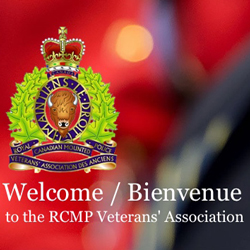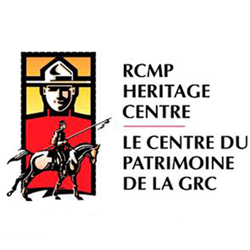RCMP and the Monarchy
 Upon the occasion of Her Majesty Queen Elizabeth II’s Diamond Jubilee, we find ourselves with cause to celebrate and reflect upon the Royal Family’s long association with the Royal Canadian Mounted Police (RCMP).
Upon the occasion of Her Majesty Queen Elizabeth II’s Diamond Jubilee, we find ourselves with cause to celebrate and reflect upon the Royal Family’s long association with the Royal Canadian Mounted Police (RCMP).
This association dates back to 1897 when the Force participated in celebrations which marked Queen Victoria’s Diamond Jubilee. When the Canadian government was deciding on what military units were to be sent to the Diamond Jubilee – it was Nicholas Davin, Member of Parliament for Regina, who continually raised in the House of Commons that the Canadian contingent should include members of the North-West Mounted Police (NWMP). In his words, they were the “finest body of men to be found in the Empire.”[1] Sir Richard Cartwright, Minister of Trade & Commerce, welcomed the unanimous vote to send the NWMP members and to represent the fact that the Canadian West was no longer a lawless frontier.
In 1897, Prime Minister Sir Wilfrid Laurier approved the sending of twenty-five NWMP members and twenty-eight horses to the Queen Victoria’s Diamond Jubilee celebrations in London.
Commissioner Lawrence Herchmer was anxious to ensure that the NWMP contingent would best represent the Force. His concern was that the Force as they would be watched by the finest cavalry regiments in the British Empire. The Commissioner requested the NWMP contingent be provided with a new modern and functional uniform. This request was approved by the Prime Minister. The key component of this new uniform was the felt hat, commonly called the “Stetson.” It was the stetson and the red serge which would symbolize the Force around the world.
In London, Prime Minister Sir Wilfrid Laurier led the Colonial contingents in the Royal Procession escorting Queen Victoria from Buckingham Palace. He was flanked by two NWMP members. At the time, the London newspapers reported on the popularity and curiosity about the Canadian Mounted Police. It was in these newspaper reports that the term “Mounties” was first used as a nickname for the Force members. However, the NWMP members at the time preferred to be known as the “Riders of the Plain.”
On July 1, 1897, Queen Victoria inspected the NWMP and the Canadian contingent at Aldershot. On the following day at Buckingham Palace, the twenty-five NWMP members received their Queen Victoria Diamond Jubilee Medal from the Prince of Wales (later to become King Edward VII).
With the outbreak of the Boer War in 1899, the government permitted 217 NWMP members to join two Canadian regiments heading to South Africa: Canadian Mounted Rifles and the Lord Strathcona Horse.
In the Boer War (1899 – 1902), the British troops were experiencing many setbacks. It was a non-traditional war. The Boers were gaining successes with their guerrilla tactics. Force members in these two Canadian regiments had considerable experience with counter-insurgency tactics. This experience had been gained in the 1885 North-West Rebellion.
These counter-insurgency tactics surprised the Boers and the regiments gained many successes. Consequently, these regiments earned a reputation as fierce fighters who distinguished themselves by their bravery, courage, and leadership. Many awards were bestowed on Force members such as: the Victoria Cross, Order of the Bath, Companions of the Order of St. Michael and St. George, Companion of the Distinguished Service Order, Victorian Order, and Distinguished Conduct Medal.
In recognition for their contributions in the Boer War, both regiments were sent from South Africa to London to be paraded through the streets and to be personally presented with their South Africa Medals by King Edward VII at Buckingham Palace.
In 1904, the prefix “Royal” was granted by King Edward VII to the Force for their member’s service in the Boer War. From the Boer War, the Force adopted the Strathcona boots, which are now known as “high browns,” and another key symbol of the RCMP.
With repeated acts of heroism and notable achievements by NWMP members, the Royal Family were drawn to travel to Regina to visit the home of the Mounted Police at “Depot” Division, Regina. Beginning in 1901, with the visit of the Duke and Duchess of Cornwall and York, members of the Royal Family have visited “Depot” Division on fourteen occasions.
On October 6, 1919, the Prince of Wales (later to become King Edward VIII) visited the “Depot” Division. He inspected recruits and made presentations. One such presentation was a King’s Police Medal to Inspector Thomas Caulkin, one of two members who completed a murder investigation by travelling 5,153 miles on a dog sled. In addition to the medal, the Prince personally gave Inspector Caulkin a gold watch.
According to news reports at the time “The Prince showed a particular interest in his visit to the Headquarters of this splendid and romantic corps. In his inspection, the Prince saw the reason why the physique of the men should be so splendid and their nerve so sure. The training of the R.N.W.M.P. makes no appeal to the weakling of spirit or flesh. He saw their firm discipline. He saw them breaking in the bucking bronchos they had to ride. He saw them go through exhausting mounted tests.
His congratulations on their wonderful show were expressed with great warmth.[2]”
In 1920, the Canadian government expanded the duties of the Force. The Royal North West Mounted Police amalgamated with the Dominion Police and the name of the Force was changed to the Royal Canadian Mounted Police. In this same year, the Prince of Wales accepted the appointment as the first Honourary Commissioner of the RCMP.
At the coronation of King George VI in 1937, the RCMP provided a contingent of two officers, thirty-five NCOs and men with thirty-five other ranks, and thirty-five horses. After the coronation, along with their horses, were invited to the Royal Mews at Buckingham Palace, for a private review by King George, Queen Elizabeth and young Princess – Elizabeth and Margaret. It has been suggested that this special request was made by the young princess Elizabeth who wanted a closer view of the scarlet Mounties and their famous horses.
On May 25, 1939, King George VI and Queen Elizabeth, accompanied by the Canadian Prime Minister William Lyon Mackenzie King, were the first ruling British monarchs to visit the “Depot” Division.
They attended a church service at the RCMP Chapel followed by a tea in the Officers’ Mess while the RCMP Band played across the street. After an hour of rest, the official delegation were given a tour of “Depot” Division. The Royals were particularly impressed with the RCMP Chapel, the Crime Laboratory and the splendid music provided by the RCMP Band.
On October 17, 1951, Princess Elizabeth and her husband Prince Philip paid a Royal Visit to “Depot” Division. As the Royal procession entered “Depot” from Dewdney Avenue, they were lead to the parade square by a mounted escort. The parade square was lined with recruits at five pace intervals. As the Royal couple exited their vehicle, the RCMP Band played the Royal Salute. They were greeted by Commissioner Leonard Nicholson who then introduced the Royals to the Minister of Justice and other dignitaries.
Before visiting the Chapel, the Royal couple took in a Musical Ride performance. At the Chapel, Princess Elizabeth mentioned that she had just spoken to her mother, Queen Elizabeth, on the telephone. Her mother commented on how impressed she was with her memories of the RCMP Chapel.
Their next place to visit was the RCMP Museum. The princess was particularly interested in certain exhibits such as: the model of the RCMP “St. Roch”, the Mad Trapper artifacts and the native artwork. The final location to be visited by the Royals ws the Officers’ Mess. Here, the Royals were presented with hard-bound copies of John Peter Turner’s two-volume work entitled “The North-West Mounted Police.”
With the death of her father in 1952, Elizabeth became Her Majesty Queen Elizabeth II. For her coronation parade on June 2, 1953, the RCMP sent a contingent of forty-six men and forty-six horses. In 1953, Queen Elizabeth became the Honourary Commissioner of the RCMP. Since that time, she has cherished her relationship with the Force.
After the coronation parade, Queen Elizabeth asked for a private inspection of the RCMP contingent at the Royal Mews at Buckingham Place with Prince Philip, Prince Charles, and Princess Anne. As the Queen and Prince Philip took a sincere interest in the background of each rider and horse that was present at the inspection.
In a visit to Regina and “Depot” Division in 1959, the Queen requested a private meeting with “Depot” Training Officer Inspector Herbert Robertson. Inspector Robertson had been born and raised on the Royal Estate at Balmoral and, as such, had many associations with the Royal Family. This private meeting provided them the opportunity to update each other on their respective families.
In 1968, Staff Sergeant Ralph Cave, the riding master for the RCMP Musical Ride, suggested that the RCMP present one of the Musical Ride’s horses to Queen Elizabeth. The suggestion was supported by the Commissioner and the Canadian government. Police Service Horse (PSH) – “Burmese” was selected to become the Queen’s horse.
In April 1969, “Burmese” accompanied the Musical Ride to London for the Royal Windsor Horse Show. On April 28, 1969 at Windsor Castle, “Burmese” was presented to Queen Elizabeth by Commissioner Malcolm Lindsay along with Staff Sergeant Ralph Cave. The Queen was extremely pleased with the presentation and asked that “Burmese” perform in a Musical Ride at the Royal Windsor Horse Show. In addition, she asked that the rider of “Burmese” carry her Royal standard on the lance instead of the traditional red and white pennon. By using the Royal standard, the Queen could easily follow the performance of “Burmese.”
As a result of receiving “Burmese”, the Queen established a friendship with Staff Sergeant Ralph Cave as they both shared a love for horses.
When Ralph Cave retired from the RCMP, the Queen continued her association with the Force and love of horses by way of the Riding Masters at the RCMP Musical Ride Training Centre at Rockcliffe Ontario.
In 1981, the Queen was riding “Burmese” in her Birthday Parade when a man in the crowd fired five blank gun shots. A regular horse would have been startled but “Burmese” remained calm due to her equitation training received at “Depot” Division. She had gained experience of gunfire during recruit training when staff would fire blank rounds as recruits took horses through their paces. The Royal Family praised the horse’s behaviour during this incident. When the Queen was asked many years later which was her favourite horse – her immediate reply was “Burmese.”
On the occasion of the Force’s 100th Anniversary in 1973, Her Majesty attended “Depot” Division to inspect the RCMP Honour Guard and present the Force with its new Guidon.
The RCMP Guidon, which measures 3’5″ by 2.3″ serves as a unique Standard for the Force and follows the British cavalry regiments. services as a unique
The Guidon bears the Queen Elizabeth II’s Royal Cypher in the upper left hand corner.
Battle honours on the Guidon are: North-West Canad 1885; South Africa 1900-02; France & Flanders 1918; Siberia 1918-1919 and Europe 1939-45.
On this occasion, the Queen was presented with her second horse from the RCMP – PSH “Centenial.”
Staff Sergeant Fred Rasmussen was twice selected to train police service horses for Her Majesty Queen Elizabeth – “Burmese” in 1969, and “Centenial” in 1973. His excellent training included exercises that developed the horse’s balance, agility, and stamina.
Rasmussen recounts a treasured story in his biography, wherein, in May 1977, he was invited, after the presentation of “Centenial” to the Queen, to ride with Her Majesty and Princess Margaret in Windsor Horne Park. The high esteem that Staff Sergeant Rasmussen was held in by Queen Elizabeth was evidenced when, in 1978, he received a personal letter from Her Majesty, expressing her appreciation of his training of “Burmese” and “Centenial” and wishing him well on his retirement from the Force.
From 1998 to 2009, the Queen would receive two more horses from the RCMP: PSH “James” in 1998 to mark the RCMP’s 125th Anniversary and PSH “George” in 2009 to mark the 40th Anniversary of presenting “Burmese” to the Queen.
In 2002, the Queen presented an Irish horse named “Golden Jubilee” to the RCMP in honour of her Golden Jubilee year.
In 2005, Queen and Prince Philip visited Saskatchewan and Alberta to celebrate the 100th anniversary of the establishment of these two provinces. On May 19, 2005, while visiting “Depot” Division, the Royal Couple laid a wreath at the RCMP Cenotaph in memory of the four members who died on March 3, 2005, near Mayerthorpe, Alberta. After the service, in the RCMP Chapel, the Queen and Prince met with the deceased member’s families.
In honour of the 50th anniversary of the reign of Queen Elizabeth II, the province of Saskatchewan commissioned sculptor Susan Velder to create a larger-than-life-size bronze statue of Her Majesty riding her favourite horse – “Burmese.” This statute, unveiled by the Queen in 2005 is situated north of the Saskatchewan Legislature in Regina. This statute, and a similar one in Ottawa are the only two statues of the Queen on a horse.
On June 8, 2009, HRH Prince Edward, The Earl of Wessex, presented a gift to the RCMP from Her Majesty the Queen. The gift was a sixteen month-old golden Labrador retriever named “Suzanna.” According to Prince Edward, Queen Elizabeth personally selected the dog with the registered name of Kenside Wallow of Sandringham and named her “Suzanna.” The name was selected from one of her favourite childhood books – Susannah: A Little Girl With The Mounties. As outlined by Prince Edward, this gift represents the long-standing relationship between the RCMP and the Royal Family.
“Suzanna” now serves as “Depot” Division’s mascot and lives with Assistant Commissioner Roger Brown – Commanding Officer of “Depot” Division.
For the Queen’s Diamond Jubilee, she was presented another horse on May 10, 2012. This horse was a five year-old mare named “Elizabeth” in honour of the late Queen Mother.
Former Riding Master – Sergeant Major Bill Stewart – was involved in the training, selecting and presentation of the two last horses presented to the Queen – PSH “George” and PSH “Elizabeth.” While in England and just prior to the presenting the Queen with “George” on May 3, 2009, Bill Stewart was riding “George” and the horse stumbled, throwing him to the ground and injuring his elbow. While in the hospital being treated for the injury, a nurse came to him and advised that a woman had called inquiring about his condition. Bill’s immediate response was, “it was probably my wife.” The nurse immediately responded, “no, it was the Queen.”
“Elizabeth,” the most recent horse presented to the Queen, had been the horse that Bill Stewart rode at the Musical Ride Centre at Rockcliffe, Ontario. Over the years, he has had the privilege to ride with Her Majesty on a few occasions in the company of her Stud Groom – Mr. Terry Pendy. The special friendship between the Queen and Bill Stewart has been enduring.
For the Queen’s Diamond Jubilee celebration, the Canadian Mint created three silver coins. One coin was created to mark the special relationship that Queen Elizabeth has with the RCMP. The member depicted on this coin is Sergeant Major Bill Stewart. On April 24, 2012, at Windsor Castle, Queen Elizabeth invested Sergeant Major Bill Stewart with the insignia of a Member of the Royal Victorian Order. This Order was established by Queen Victoria on April 21, 1896, as a reward for extraordinary, important or personal service performed for the Sovereign or the Royal Family.
On May 10, 2012, RCMP Commissioner Bob Paulson conferred the title of “Commissioner in Chief of the RCMP” on the Queen, and the Prime Minister conferred the Queen’s former title of “Honorary Commissioner” on Prince Charles, the Prince of Wales.
In response to this appointment, Queen Elizabeth broke with tradition and asked that the RCMP replace her Queen’s Life Guard at Buckingham Palace for one day during her Diamond Jubilee celebrations. For the past 350 years, the Household Cavalry has provided this ceremonial guard to the ruling monarch at Buckingham Place.
On May 23, 2012, an official ceremony took place as the Queen’s Life Guard was replaced by fifteen members of the RCMP. This high honour marked the first time that a non-military unit would be guarding the Sovereign. It was reported that the Queen was at the window as the mounted RCMP delegation rode past Buckingham Palace. As outlined by Bill Stewart, “this is a really unique thrill for us and an event upon which I can head into my retirement from the Force.”
The RCMP is proud of its relationship with Her Majesty Queen Elizabeth. In the British press, the Force is commonly referred to as the Queen’s “beloved Mounties.”


 September 6, 2012
September 6, 2012 





























